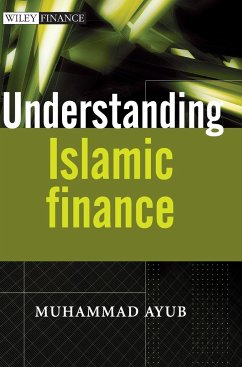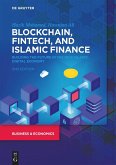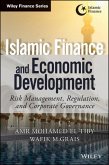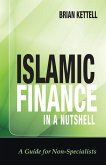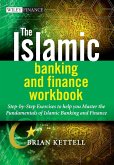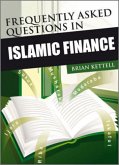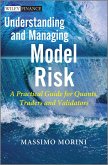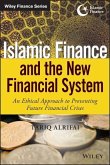Muhammad Ayub
Understanding Islamic Finance
Muhammad Ayub
Understanding Islamic Finance
- Gebundenes Buch
- Merkliste
- Auf die Merkliste
- Bewerten Bewerten
- Teilen
- Produkt teilen
- Produkterinnerung
- Produkterinnerung
In Understanding Islamic Finance Muhammad Ayub introduces all the essential elements of this growing market by providing an in-depth background to the subject and clear descriptions of all the major products and processes associated with Islamic finance.
Key features include: _ Discussion of the principles of Islamic finance; _ Introduction to the key products and procedures that International Financial Institutions are using or may adopt to fund a variety of clients ensuring Shar+´ah compliance; _ Discussion of the role Islamic finance can play in the development of the financial system…mehr
Andere Kunden interessierten sich auch für
![Blockchain, Fintech, and Islamic Finance Blockchain, Fintech, and Islamic Finance]() Hazik MohamedBlockchain, Fintech, and Islamic Finance30,95 €
Hazik MohamedBlockchain, Fintech, and Islamic Finance30,95 €![Islamic Finance and Economic Development Islamic Finance and Economic Development]() Amr Mohamed El Tiby AhmedIslamic Finance and Economic Development80,99 €
Amr Mohamed El Tiby AhmedIslamic Finance and Economic Development80,99 €![Islamic Finance in a Nutshell Islamic Finance in a Nutshell]() Brian KettellIslamic Finance in a Nutshell28,99 €
Brian KettellIslamic Finance in a Nutshell28,99 €![The Islamic Banking and Finance Workbook The Islamic Banking and Finance Workbook]() Brian B. KettellThe Islamic Banking and Finance Workbook49,99 €
Brian B. KettellThe Islamic Banking and Finance Workbook49,99 €![Frequently Asked Questions in Islamic Finance Frequently Asked Questions in Islamic Finance]() Brian KettellFrequently Asked Questions in Islamic Finance33,99 €
Brian KettellFrequently Asked Questions in Islamic Finance33,99 €![Understanding and Managing Model Risk Understanding and Managing Model Risk]() Massimo MoriniUnderstanding and Managing Model Risk114,99 €
Massimo MoriniUnderstanding and Managing Model Risk114,99 €![Islamic Finance and the New Financial System Islamic Finance and the New Financial System]() Tariq AlrifaiIslamic Finance and the New Financial System51,99 €
Tariq AlrifaiIslamic Finance and the New Financial System51,99 €-
-
-
In Understanding Islamic Finance Muhammad Ayub introduces all the essential elements of this growing market by providing an in-depth background to the subject and clear descriptions of all the major products and processes associated with Islamic finance.
Key features include:
_ Discussion of the principles of Islamic finance;
_ Introduction to the key products and procedures that International Financial Institutions are using or may adopt to fund a variety of clients ensuring Shar+´ah compliance;
_ Discussion of the role Islamic finance can play in the development of the financial system and of economies;
_ Practical and operational examples that cover deposit and fund management by banks involving financing of various sectors of the economy, risk management, accounting treatment, and working of Islamic financial markets and instruments.
This book is not only an important text for all banks and financial institutions entering this particular market with a commitment to building Islamic financial solutions, but is also essential reading for undergraduate and postgraduate students of Islamic finance.
Hinweis: Dieser Artikel kann nur an eine deutsche Lieferadresse ausgeliefert werden.
Key features include:
_ Discussion of the principles of Islamic finance;
_ Introduction to the key products and procedures that International Financial Institutions are using or may adopt to fund a variety of clients ensuring Shar+´ah compliance;
_ Discussion of the role Islamic finance can play in the development of the financial system and of economies;
_ Practical and operational examples that cover deposit and fund management by banks involving financing of various sectors of the economy, risk management, accounting treatment, and working of Islamic financial markets and instruments.
This book is not only an important text for all banks and financial institutions entering this particular market with a commitment to building Islamic financial solutions, but is also essential reading for undergraduate and postgraduate students of Islamic finance.
Hinweis: Dieser Artikel kann nur an eine deutsche Lieferadresse ausgeliefert werden.
Produktdetails
- Produktdetails
- Wiley Finance Series
- Verlag: Wiley & Sons
- Artikelnr. des Verlages: 14503069000
- 1. Auflage
- Seitenzahl: 544
- Erscheinungstermin: 1. Dezember 2007
- Englisch
- Abmessung: 250mm x 175mm x 34mm
- Gewicht: 1085g
- ISBN-13: 9780470030691
- ISBN-10: 0470030690
- Artikelnr.: 22580204
- Herstellerkennzeichnung
- Libri GmbH
- Europaallee 1
- 36244 Bad Hersfeld
- gpsr@libri.de
- Wiley Finance Series
- Verlag: Wiley & Sons
- Artikelnr. des Verlages: 14503069000
- 1. Auflage
- Seitenzahl: 544
- Erscheinungstermin: 1. Dezember 2007
- Englisch
- Abmessung: 250mm x 175mm x 34mm
- Gewicht: 1085g
- ISBN-13: 9780470030691
- ISBN-10: 0470030690
- Artikelnr.: 22580204
- Herstellerkennzeichnung
- Libri GmbH
- Europaallee 1
- 36244 Bad Hersfeld
- gpsr@libri.de
MUHAMMAD AYUB is Director Training, Development and Shari'ah Aspects at IIBI, London. Formerly, he was with the State Bank of Pakistan (central bank) where he headed the Islamic Economics Division and Shari'ah Compliance Division as Senior Joint Director in the Research and Islamic Banking Departments. He also served as Head of Islamic Banking at NIBAF, the training wing of SBP. Besides contributing a large amount of material, he has been serving as Master Trainer on theory and practice of Islamic finance. For last two decades, he has been involved in R&D for facilitating I.B. Industry, Products Development, IB Prudential regulations, Risk management and Shari'ah related controls and audit of Islamic banking institutions. This, along with his association with various Commissions set up from time to time on application of Islamic banking system, has lent him a pragmatic and balanced approach, a prerequisite for presenting such a book.
List of Boxes and Figures xvii Foreword xix Preface xxi Acknowledgements xxv PART I FUNDAMENTALS 1 1 Introduction 3 1.1 Economic Scenario in the Neoclassical Framework 3 1.2 Conventional Debt: A Recipe for Exploitation 4 1.3 Growth per se May not Lead to Socio-economic Justice 6 1.4 Social Welfare Activities of the States 8 1.5 The Main Culprit 8 1.6 The Need of the Hour 9 1.7 Economics and Religion 10 1.8 Islamic Principles Can Make the Difference 11 1.9 Regulating Trade and Business 13 1.10 Islamic Finance Passing Significant Milestones 15 1.11 Could it Work to Achieve the Objectives? 16 1.12 About this Book 17 2 Distinguishing Features of the Islamic Economic System 21 2.1 Introduction 21 2.2 Islamic Sharî
ah and its Objectives 21 2.3 Why Study Islamic Economics? 25 2.4 Islamic Economics: What should it be? 30 2.5 Paraphernalia of Islamic Economics 32 2.6 Summary 41 3 The Main Prohibitions and Business Ethics in Islamic Economics and Finance 43 3.1 Introduction 43 3.2 The Basic Prohibitions 43 3.3 Business Ethics and Norms 64 3.4 Summary and Conclusion 70 4 The Philosophy and Features of Islamic Finance 73 4.1 Introduction 73 4.2 The Philosophy of Islamic Finance 73 4.3 Debt versus Equity 85 4.4 Islamic Banking: Business versus Benevolence 86 4.5 Exchange Rules 87 4.6 Time Value of Money in Islamic Finance 89 4.7 Money, Monetary Policy and Islamic Finance 90 4.8 Summary 96 PART II CONTRACTUAL BASES IN ISLAMIC FINANCE 99 5 Islamic Law of Contracts and Business Transactions 101 5.1 Introduction 101 5.2 Mâl (Wealth), Usufruct and Ownership 101 5.3 General Framework of Contracts 105 5.4 Elements of a Contract 106 5.5 Broad Rules for the Validity of Mu'âmalât 110 5.6 W'adah (Promise) and Related Matters 114 5.7 Types of Contracts 117 5.8 Commutative and Noncommutative Contracts 124 5.9 Conditional or Contingent Contracts 126 5.10 Summary 127 6 Trading in Islamic Commercial Law 129 6.1 Introduction 129 6.2 Bai' - Exchange of Values 130 6.3 Legality of Trading 131 6.4 Types of Bai' 133 6.5 Requirements of a Valid Sale Contract 133 6.6 Riba Involvement in Sales 142 6.7 Gharar - A Cause of Prohibition of Sales 143 6.8 Conditional Sales and "Two Bargains in One Sale" 144 6.9 Bai' al'Arbûn (Downpayment Sale) 145 6.10 Bai' al Dayn (Sale of Debt) 146 6.11 Al 'Inah Sale and the Use of Ruses (Hiyal) 147 6.12 Options in Sales (Khiyar) 150 6.13 Summary 152 7 Loan and Debt in Islamic Commercial Law 155 7.1 Introduction 155 7.2 The Terms Defined 155 7.3 Illegality of Commercial Interest 157 7.4 Loaning and the Banking System 158 7.5 Guidance from the Holy Qur'ân on Loans and Debts 159 7.6 The Substance of Loans 159 7.7 Repayment of the Principal Only 160 7.8 Time Value of Money in Loans and Debts 160 7.9 Instructions for the Debtor 161 7.10 Instructions for the Creditor 162 7.11 Husnal Qadha (Gracious Payment of Loan/Debt) 162 7.12 Remitting a Part of a Loan and Prepayment Rebate 163 7.13 Penalty on Default 165 7.14 Hawalah (Assignment of Debt) 167 7.15 Security/Guarantee (Kafalah) in Loans 168 7.16 Bai' al Dayn (Sale of Debt/Debt Instruments) 172 7.17 Impact of Inflation on Loans/Debts 172 7.18 Summary 174 PART III ISLAMIC FINANCE - PRODUCTS AND PROCEDURES 177 8 Overview of Financial Institutions and Products: Conventional and Islamic 179 8.1 Introduction 179 8.2 What is Banking or a Bank? 179 8.3 The Strategic Position of Banks and Financial Institutions 180 8.4 Categories of Conventional Financial Business 181 8.5 The Need for Islamic Banks and NBFIs 185 8.6 The Issue of Mode Preference 195 8.7 Islamic Investment Banking 199 8.8 Islamic Financial Markets and Instruments 199 8.9 Summary and Conclusion 211 9 Murabaha and Musawamah 213 9.1 Introduction 213 9.2 Conditions of Valid Bai' 214 9.3 Murabaha - a Bai' al Amânah 215 9.4 Bai' Murabaha in Classical Literature 215 9.5 The Need for Murabaha 216 9.6 Specific Conditions of Murabaha 217 9.7 Possible Structures of Murabaha 220 9.8 Murabaha to Purchase Orderer (MPO) 222 9.9 Issues in Murabaha 229 9.10 Precautions in Murabaha Operations 233 9.11 Musawamah (Bargaining on Price) 234 9.12 Summary 238 10 Forward Sales: Salam and Istisna'a 241 10.1 Introduction 241 10.2 Bai' Salam/Salaf 241 10.3 Benefits of Salam and the Economic Role of Bai' Salam 242 10.4 Features of a Valid Salam Contract 243 10.5 Security, Pledge and Liability of the Sureties 249 10.6 Disposing of the Goods Purchased on Salam 250 10.7 Salam - Post Execution Scenarios 252 10.8 Salam-Based Securitization - Salam Certificates/Sukuk 254 10.9 Summary of Salam Rules 255 10.10 Salam as a Financing Technique by Banks 257 10.11 Istisna'a (Order to Manufacture) 263 11 Ijarah - Leasing 279 11.1 Introduction 279 11.2 Essentials of Ijarah Contracts 280 11.3 General Juristic Rules of Ijarah 281 11.4 Modern Use of Ijarah 287 11.5 Islamic Banks' Ijarah Muntahia-bi-Tamleek 291 11.6 Summary of Guidelines for Islamic Bankers on Ijarah 298 12 Participatory Modes: Shirkah and its Variants 307 12.1 Introduction 307 12.2 Legality, Forms and Definition of Partnership 308 12.3 Basic Rules of Musharakah 312 12.4 The Concept and Rules of Mudarabah 320 12.5 Mudarabah Distinguished from Musharakah 327 12.6 Modern Corporations: Joint Stock Companies 328 12.7 Modern Application of the Concept of Shirkah 330 12.8 Diminishing Musharakah 337 12.9 Diminishing Musharakah as an Islamic Mode of Finance 339 12.10 Summary and Conclusion 343 13 Some Accessory Contracts 347 13.1 Introduction 347 13.2 Wakalah (Agency) 347 13.3 Tawarruq 349 13.4 Ju'alah 351 13.5 Bai' al Istijrar (Supply Contract) 355 14 Application of the System: Financing Principles and Practices 357 14.1 Introduction 357 14.2 Product Development 358 14.3 The Nature of Financial Services/Business 358 14.4 Prospects and Issues in Specific Areas of Financing 369 14.5 Islamic Banks' Relationship with Conventional Banks 384 14.6 Fee-based Islamic Banking Services 384 14.7 Summary and Conclusion 386 Appendix: The Major Functions of a Sharî
ah Supervisory Board In the Light of the AAOIFI's Sharî
ah Standard 387 15 Sukuk and Securitization: Vital Issues in Islamic Capital Markets 389 15.1 Introduction 389 15.2 The Capital Market in an Islamic Framework 390 15.3 Securitization and Sukuk 391 15.4 Summary and Conclusion 412 16 Takaful: An Alternative to Conventional Insurance 417 16.1 Introduction 417 16.2 The Need for Takaful Cover 417 16.3 The Sharî
ah Basis of Takaful 420 16.4 How the Takaful System Works 422 16.5 Takaful and Conventional Insurance Compared 427 16.6 Status and Potential of the Takaful Industry 428 16.7 Takaful Challenges 429 Appendix: Fatâwa (Juristic Opinions) on Different Aspects of Insurance 430 17 An Appraisal of Common Criticism of Islamic Banking and Finance 433 17.1 Introduction 433 17.2 The Common Myths and Objections 433 17.3 Appraisal of Conceptual Criticism 436 17.4 Appraisal of Criticism on Islamic Banking Practice 445 17.5 Conclusion 456 18 The Way Forward 457 18.1 Introduction 457 18.2 Agenda for the Policymakers 457 18.3 Potential, Issues and Challenges for Islamic Banking 461 18.4 Conclusion 479 Acronyms 481 Glossary 485 Bibliography English Sources 497 Arabic/Urdu Sources 503 Suggested Further Readings 505 Index 509
ah and its Objectives 21 2.3 Why Study Islamic Economics? 25 2.4 Islamic Economics: What should it be? 30 2.5 Paraphernalia of Islamic Economics 32 2.6 Summary 41 3 The Main Prohibitions and Business Ethics in Islamic Economics and Finance 43 3.1 Introduction 43 3.2 The Basic Prohibitions 43 3.3 Business Ethics and Norms 64 3.4 Summary and Conclusion 70 4 The Philosophy and Features of Islamic Finance 73 4.1 Introduction 73 4.2 The Philosophy of Islamic Finance 73 4.3 Debt versus Equity 85 4.4 Islamic Banking: Business versus Benevolence 86 4.5 Exchange Rules 87 4.6 Time Value of Money in Islamic Finance 89 4.7 Money, Monetary Policy and Islamic Finance 90 4.8 Summary 96 PART II CONTRACTUAL BASES IN ISLAMIC FINANCE 99 5 Islamic Law of Contracts and Business Transactions 101 5.1 Introduction 101 5.2 Mâl (Wealth), Usufruct and Ownership 101 5.3 General Framework of Contracts 105 5.4 Elements of a Contract 106 5.5 Broad Rules for the Validity of Mu'âmalât 110 5.6 W'adah (Promise) and Related Matters 114 5.7 Types of Contracts 117 5.8 Commutative and Noncommutative Contracts 124 5.9 Conditional or Contingent Contracts 126 5.10 Summary 127 6 Trading in Islamic Commercial Law 129 6.1 Introduction 129 6.2 Bai' - Exchange of Values 130 6.3 Legality of Trading 131 6.4 Types of Bai' 133 6.5 Requirements of a Valid Sale Contract 133 6.6 Riba Involvement in Sales 142 6.7 Gharar - A Cause of Prohibition of Sales 143 6.8 Conditional Sales and "Two Bargains in One Sale" 144 6.9 Bai' al'Arbûn (Downpayment Sale) 145 6.10 Bai' al Dayn (Sale of Debt) 146 6.11 Al 'Inah Sale and the Use of Ruses (Hiyal) 147 6.12 Options in Sales (Khiyar) 150 6.13 Summary 152 7 Loan and Debt in Islamic Commercial Law 155 7.1 Introduction 155 7.2 The Terms Defined 155 7.3 Illegality of Commercial Interest 157 7.4 Loaning and the Banking System 158 7.5 Guidance from the Holy Qur'ân on Loans and Debts 159 7.6 The Substance of Loans 159 7.7 Repayment of the Principal Only 160 7.8 Time Value of Money in Loans and Debts 160 7.9 Instructions for the Debtor 161 7.10 Instructions for the Creditor 162 7.11 Husnal Qadha (Gracious Payment of Loan/Debt) 162 7.12 Remitting a Part of a Loan and Prepayment Rebate 163 7.13 Penalty on Default 165 7.14 Hawalah (Assignment of Debt) 167 7.15 Security/Guarantee (Kafalah) in Loans 168 7.16 Bai' al Dayn (Sale of Debt/Debt Instruments) 172 7.17 Impact of Inflation on Loans/Debts 172 7.18 Summary 174 PART III ISLAMIC FINANCE - PRODUCTS AND PROCEDURES 177 8 Overview of Financial Institutions and Products: Conventional and Islamic 179 8.1 Introduction 179 8.2 What is Banking or a Bank? 179 8.3 The Strategic Position of Banks and Financial Institutions 180 8.4 Categories of Conventional Financial Business 181 8.5 The Need for Islamic Banks and NBFIs 185 8.6 The Issue of Mode Preference 195 8.7 Islamic Investment Banking 199 8.8 Islamic Financial Markets and Instruments 199 8.9 Summary and Conclusion 211 9 Murabaha and Musawamah 213 9.1 Introduction 213 9.2 Conditions of Valid Bai' 214 9.3 Murabaha - a Bai' al Amânah 215 9.4 Bai' Murabaha in Classical Literature 215 9.5 The Need for Murabaha 216 9.6 Specific Conditions of Murabaha 217 9.7 Possible Structures of Murabaha 220 9.8 Murabaha to Purchase Orderer (MPO) 222 9.9 Issues in Murabaha 229 9.10 Precautions in Murabaha Operations 233 9.11 Musawamah (Bargaining on Price) 234 9.12 Summary 238 10 Forward Sales: Salam and Istisna'a 241 10.1 Introduction 241 10.2 Bai' Salam/Salaf 241 10.3 Benefits of Salam and the Economic Role of Bai' Salam 242 10.4 Features of a Valid Salam Contract 243 10.5 Security, Pledge and Liability of the Sureties 249 10.6 Disposing of the Goods Purchased on Salam 250 10.7 Salam - Post Execution Scenarios 252 10.8 Salam-Based Securitization - Salam Certificates/Sukuk 254 10.9 Summary of Salam Rules 255 10.10 Salam as a Financing Technique by Banks 257 10.11 Istisna'a (Order to Manufacture) 263 11 Ijarah - Leasing 279 11.1 Introduction 279 11.2 Essentials of Ijarah Contracts 280 11.3 General Juristic Rules of Ijarah 281 11.4 Modern Use of Ijarah 287 11.5 Islamic Banks' Ijarah Muntahia-bi-Tamleek 291 11.6 Summary of Guidelines for Islamic Bankers on Ijarah 298 12 Participatory Modes: Shirkah and its Variants 307 12.1 Introduction 307 12.2 Legality, Forms and Definition of Partnership 308 12.3 Basic Rules of Musharakah 312 12.4 The Concept and Rules of Mudarabah 320 12.5 Mudarabah Distinguished from Musharakah 327 12.6 Modern Corporations: Joint Stock Companies 328 12.7 Modern Application of the Concept of Shirkah 330 12.8 Diminishing Musharakah 337 12.9 Diminishing Musharakah as an Islamic Mode of Finance 339 12.10 Summary and Conclusion 343 13 Some Accessory Contracts 347 13.1 Introduction 347 13.2 Wakalah (Agency) 347 13.3 Tawarruq 349 13.4 Ju'alah 351 13.5 Bai' al Istijrar (Supply Contract) 355 14 Application of the System: Financing Principles and Practices 357 14.1 Introduction 357 14.2 Product Development 358 14.3 The Nature of Financial Services/Business 358 14.4 Prospects and Issues in Specific Areas of Financing 369 14.5 Islamic Banks' Relationship with Conventional Banks 384 14.6 Fee-based Islamic Banking Services 384 14.7 Summary and Conclusion 386 Appendix: The Major Functions of a Sharî
ah Supervisory Board In the Light of the AAOIFI's Sharî
ah Standard 387 15 Sukuk and Securitization: Vital Issues in Islamic Capital Markets 389 15.1 Introduction 389 15.2 The Capital Market in an Islamic Framework 390 15.3 Securitization and Sukuk 391 15.4 Summary and Conclusion 412 16 Takaful: An Alternative to Conventional Insurance 417 16.1 Introduction 417 16.2 The Need for Takaful Cover 417 16.3 The Sharî
ah Basis of Takaful 420 16.4 How the Takaful System Works 422 16.5 Takaful and Conventional Insurance Compared 427 16.6 Status and Potential of the Takaful Industry 428 16.7 Takaful Challenges 429 Appendix: Fatâwa (Juristic Opinions) on Different Aspects of Insurance 430 17 An Appraisal of Common Criticism of Islamic Banking and Finance 433 17.1 Introduction 433 17.2 The Common Myths and Objections 433 17.3 Appraisal of Conceptual Criticism 436 17.4 Appraisal of Criticism on Islamic Banking Practice 445 17.5 Conclusion 456 18 The Way Forward 457 18.1 Introduction 457 18.2 Agenda for the Policymakers 457 18.3 Potential, Issues and Challenges for Islamic Banking 461 18.4 Conclusion 479 Acronyms 481 Glossary 485 Bibliography English Sources 497 Arabic/Urdu Sources 503 Suggested Further Readings 505 Index 509
List of Boxes and Figures xvii Foreword xix Preface xxi Acknowledgements xxv PART I FUNDAMENTALS 1 1 Introduction 3 1.1 Economic Scenario in the Neoclassical Framework 3 1.2 Conventional Debt: A Recipe for Exploitation 4 1.3 Growth per se May not Lead to Socio-economic Justice 6 1.4 Social Welfare Activities of the States 8 1.5 The Main Culprit 8 1.6 The Need of the Hour 9 1.7 Economics and Religion 10 1.8 Islamic Principles Can Make the Difference 11 1.9 Regulating Trade and Business 13 1.10 Islamic Finance Passing Significant Milestones 15 1.11 Could it Work to Achieve the Objectives? 16 1.12 About this Book 17 2 Distinguishing Features of the Islamic Economic System 21 2.1 Introduction 21 2.2 Islamic Sharî
ah and its Objectives 21 2.3 Why Study Islamic Economics? 25 2.4 Islamic Economics: What should it be? 30 2.5 Paraphernalia of Islamic Economics 32 2.6 Summary 41 3 The Main Prohibitions and Business Ethics in Islamic Economics and Finance 43 3.1 Introduction 43 3.2 The Basic Prohibitions 43 3.3 Business Ethics and Norms 64 3.4 Summary and Conclusion 70 4 The Philosophy and Features of Islamic Finance 73 4.1 Introduction 73 4.2 The Philosophy of Islamic Finance 73 4.3 Debt versus Equity 85 4.4 Islamic Banking: Business versus Benevolence 86 4.5 Exchange Rules 87 4.6 Time Value of Money in Islamic Finance 89 4.7 Money, Monetary Policy and Islamic Finance 90 4.8 Summary 96 PART II CONTRACTUAL BASES IN ISLAMIC FINANCE 99 5 Islamic Law of Contracts and Business Transactions 101 5.1 Introduction 101 5.2 Mâl (Wealth), Usufruct and Ownership 101 5.3 General Framework of Contracts 105 5.4 Elements of a Contract 106 5.5 Broad Rules for the Validity of Mu'âmalât 110 5.6 W'adah (Promise) and Related Matters 114 5.7 Types of Contracts 117 5.8 Commutative and Noncommutative Contracts 124 5.9 Conditional or Contingent Contracts 126 5.10 Summary 127 6 Trading in Islamic Commercial Law 129 6.1 Introduction 129 6.2 Bai' - Exchange of Values 130 6.3 Legality of Trading 131 6.4 Types of Bai' 133 6.5 Requirements of a Valid Sale Contract 133 6.6 Riba Involvement in Sales 142 6.7 Gharar - A Cause of Prohibition of Sales 143 6.8 Conditional Sales and "Two Bargains in One Sale" 144 6.9 Bai' al'Arbûn (Downpayment Sale) 145 6.10 Bai' al Dayn (Sale of Debt) 146 6.11 Al 'Inah Sale and the Use of Ruses (Hiyal) 147 6.12 Options in Sales (Khiyar) 150 6.13 Summary 152 7 Loan and Debt in Islamic Commercial Law 155 7.1 Introduction 155 7.2 The Terms Defined 155 7.3 Illegality of Commercial Interest 157 7.4 Loaning and the Banking System 158 7.5 Guidance from the Holy Qur'ân on Loans and Debts 159 7.6 The Substance of Loans 159 7.7 Repayment of the Principal Only 160 7.8 Time Value of Money in Loans and Debts 160 7.9 Instructions for the Debtor 161 7.10 Instructions for the Creditor 162 7.11 Husnal Qadha (Gracious Payment of Loan/Debt) 162 7.12 Remitting a Part of a Loan and Prepayment Rebate 163 7.13 Penalty on Default 165 7.14 Hawalah (Assignment of Debt) 167 7.15 Security/Guarantee (Kafalah) in Loans 168 7.16 Bai' al Dayn (Sale of Debt/Debt Instruments) 172 7.17 Impact of Inflation on Loans/Debts 172 7.18 Summary 174 PART III ISLAMIC FINANCE - PRODUCTS AND PROCEDURES 177 8 Overview of Financial Institutions and Products: Conventional and Islamic 179 8.1 Introduction 179 8.2 What is Banking or a Bank? 179 8.3 The Strategic Position of Banks and Financial Institutions 180 8.4 Categories of Conventional Financial Business 181 8.5 The Need for Islamic Banks and NBFIs 185 8.6 The Issue of Mode Preference 195 8.7 Islamic Investment Banking 199 8.8 Islamic Financial Markets and Instruments 199 8.9 Summary and Conclusion 211 9 Murabaha and Musawamah 213 9.1 Introduction 213 9.2 Conditions of Valid Bai' 214 9.3 Murabaha - a Bai' al Amânah 215 9.4 Bai' Murabaha in Classical Literature 215 9.5 The Need for Murabaha 216 9.6 Specific Conditions of Murabaha 217 9.7 Possible Structures of Murabaha 220 9.8 Murabaha to Purchase Orderer (MPO) 222 9.9 Issues in Murabaha 229 9.10 Precautions in Murabaha Operations 233 9.11 Musawamah (Bargaining on Price) 234 9.12 Summary 238 10 Forward Sales: Salam and Istisna'a 241 10.1 Introduction 241 10.2 Bai' Salam/Salaf 241 10.3 Benefits of Salam and the Economic Role of Bai' Salam 242 10.4 Features of a Valid Salam Contract 243 10.5 Security, Pledge and Liability of the Sureties 249 10.6 Disposing of the Goods Purchased on Salam 250 10.7 Salam - Post Execution Scenarios 252 10.8 Salam-Based Securitization - Salam Certificates/Sukuk 254 10.9 Summary of Salam Rules 255 10.10 Salam as a Financing Technique by Banks 257 10.11 Istisna'a (Order to Manufacture) 263 11 Ijarah - Leasing 279 11.1 Introduction 279 11.2 Essentials of Ijarah Contracts 280 11.3 General Juristic Rules of Ijarah 281 11.4 Modern Use of Ijarah 287 11.5 Islamic Banks' Ijarah Muntahia-bi-Tamleek 291 11.6 Summary of Guidelines for Islamic Bankers on Ijarah 298 12 Participatory Modes: Shirkah and its Variants 307 12.1 Introduction 307 12.2 Legality, Forms and Definition of Partnership 308 12.3 Basic Rules of Musharakah 312 12.4 The Concept and Rules of Mudarabah 320 12.5 Mudarabah Distinguished from Musharakah 327 12.6 Modern Corporations: Joint Stock Companies 328 12.7 Modern Application of the Concept of Shirkah 330 12.8 Diminishing Musharakah 337 12.9 Diminishing Musharakah as an Islamic Mode of Finance 339 12.10 Summary and Conclusion 343 13 Some Accessory Contracts 347 13.1 Introduction 347 13.2 Wakalah (Agency) 347 13.3 Tawarruq 349 13.4 Ju'alah 351 13.5 Bai' al Istijrar (Supply Contract) 355 14 Application of the System: Financing Principles and Practices 357 14.1 Introduction 357 14.2 Product Development 358 14.3 The Nature of Financial Services/Business 358 14.4 Prospects and Issues in Specific Areas of Financing 369 14.5 Islamic Banks' Relationship with Conventional Banks 384 14.6 Fee-based Islamic Banking Services 384 14.7 Summary and Conclusion 386 Appendix: The Major Functions of a Sharî
ah Supervisory Board In the Light of the AAOIFI's Sharî
ah Standard 387 15 Sukuk and Securitization: Vital Issues in Islamic Capital Markets 389 15.1 Introduction 389 15.2 The Capital Market in an Islamic Framework 390 15.3 Securitization and Sukuk 391 15.4 Summary and Conclusion 412 16 Takaful: An Alternative to Conventional Insurance 417 16.1 Introduction 417 16.2 The Need for Takaful Cover 417 16.3 The Sharî
ah Basis of Takaful 420 16.4 How the Takaful System Works 422 16.5 Takaful and Conventional Insurance Compared 427 16.6 Status and Potential of the Takaful Industry 428 16.7 Takaful Challenges 429 Appendix: Fatâwa (Juristic Opinions) on Different Aspects of Insurance 430 17 An Appraisal of Common Criticism of Islamic Banking and Finance 433 17.1 Introduction 433 17.2 The Common Myths and Objections 433 17.3 Appraisal of Conceptual Criticism 436 17.4 Appraisal of Criticism on Islamic Banking Practice 445 17.5 Conclusion 456 18 The Way Forward 457 18.1 Introduction 457 18.2 Agenda for the Policymakers 457 18.3 Potential, Issues and Challenges for Islamic Banking 461 18.4 Conclusion 479 Acronyms 481 Glossary 485 Bibliography English Sources 497 Arabic/Urdu Sources 503 Suggested Further Readings 505 Index 509
ah and its Objectives 21 2.3 Why Study Islamic Economics? 25 2.4 Islamic Economics: What should it be? 30 2.5 Paraphernalia of Islamic Economics 32 2.6 Summary 41 3 The Main Prohibitions and Business Ethics in Islamic Economics and Finance 43 3.1 Introduction 43 3.2 The Basic Prohibitions 43 3.3 Business Ethics and Norms 64 3.4 Summary and Conclusion 70 4 The Philosophy and Features of Islamic Finance 73 4.1 Introduction 73 4.2 The Philosophy of Islamic Finance 73 4.3 Debt versus Equity 85 4.4 Islamic Banking: Business versus Benevolence 86 4.5 Exchange Rules 87 4.6 Time Value of Money in Islamic Finance 89 4.7 Money, Monetary Policy and Islamic Finance 90 4.8 Summary 96 PART II CONTRACTUAL BASES IN ISLAMIC FINANCE 99 5 Islamic Law of Contracts and Business Transactions 101 5.1 Introduction 101 5.2 Mâl (Wealth), Usufruct and Ownership 101 5.3 General Framework of Contracts 105 5.4 Elements of a Contract 106 5.5 Broad Rules for the Validity of Mu'âmalât 110 5.6 W'adah (Promise) and Related Matters 114 5.7 Types of Contracts 117 5.8 Commutative and Noncommutative Contracts 124 5.9 Conditional or Contingent Contracts 126 5.10 Summary 127 6 Trading in Islamic Commercial Law 129 6.1 Introduction 129 6.2 Bai' - Exchange of Values 130 6.3 Legality of Trading 131 6.4 Types of Bai' 133 6.5 Requirements of a Valid Sale Contract 133 6.6 Riba Involvement in Sales 142 6.7 Gharar - A Cause of Prohibition of Sales 143 6.8 Conditional Sales and "Two Bargains in One Sale" 144 6.9 Bai' al'Arbûn (Downpayment Sale) 145 6.10 Bai' al Dayn (Sale of Debt) 146 6.11 Al 'Inah Sale and the Use of Ruses (Hiyal) 147 6.12 Options in Sales (Khiyar) 150 6.13 Summary 152 7 Loan and Debt in Islamic Commercial Law 155 7.1 Introduction 155 7.2 The Terms Defined 155 7.3 Illegality of Commercial Interest 157 7.4 Loaning and the Banking System 158 7.5 Guidance from the Holy Qur'ân on Loans and Debts 159 7.6 The Substance of Loans 159 7.7 Repayment of the Principal Only 160 7.8 Time Value of Money in Loans and Debts 160 7.9 Instructions for the Debtor 161 7.10 Instructions for the Creditor 162 7.11 Husnal Qadha (Gracious Payment of Loan/Debt) 162 7.12 Remitting a Part of a Loan and Prepayment Rebate 163 7.13 Penalty on Default 165 7.14 Hawalah (Assignment of Debt) 167 7.15 Security/Guarantee (Kafalah) in Loans 168 7.16 Bai' al Dayn (Sale of Debt/Debt Instruments) 172 7.17 Impact of Inflation on Loans/Debts 172 7.18 Summary 174 PART III ISLAMIC FINANCE - PRODUCTS AND PROCEDURES 177 8 Overview of Financial Institutions and Products: Conventional and Islamic 179 8.1 Introduction 179 8.2 What is Banking or a Bank? 179 8.3 The Strategic Position of Banks and Financial Institutions 180 8.4 Categories of Conventional Financial Business 181 8.5 The Need for Islamic Banks and NBFIs 185 8.6 The Issue of Mode Preference 195 8.7 Islamic Investment Banking 199 8.8 Islamic Financial Markets and Instruments 199 8.9 Summary and Conclusion 211 9 Murabaha and Musawamah 213 9.1 Introduction 213 9.2 Conditions of Valid Bai' 214 9.3 Murabaha - a Bai' al Amânah 215 9.4 Bai' Murabaha in Classical Literature 215 9.5 The Need for Murabaha 216 9.6 Specific Conditions of Murabaha 217 9.7 Possible Structures of Murabaha 220 9.8 Murabaha to Purchase Orderer (MPO) 222 9.9 Issues in Murabaha 229 9.10 Precautions in Murabaha Operations 233 9.11 Musawamah (Bargaining on Price) 234 9.12 Summary 238 10 Forward Sales: Salam and Istisna'a 241 10.1 Introduction 241 10.2 Bai' Salam/Salaf 241 10.3 Benefits of Salam and the Economic Role of Bai' Salam 242 10.4 Features of a Valid Salam Contract 243 10.5 Security, Pledge and Liability of the Sureties 249 10.6 Disposing of the Goods Purchased on Salam 250 10.7 Salam - Post Execution Scenarios 252 10.8 Salam-Based Securitization - Salam Certificates/Sukuk 254 10.9 Summary of Salam Rules 255 10.10 Salam as a Financing Technique by Banks 257 10.11 Istisna'a (Order to Manufacture) 263 11 Ijarah - Leasing 279 11.1 Introduction 279 11.2 Essentials of Ijarah Contracts 280 11.3 General Juristic Rules of Ijarah 281 11.4 Modern Use of Ijarah 287 11.5 Islamic Banks' Ijarah Muntahia-bi-Tamleek 291 11.6 Summary of Guidelines for Islamic Bankers on Ijarah 298 12 Participatory Modes: Shirkah and its Variants 307 12.1 Introduction 307 12.2 Legality, Forms and Definition of Partnership 308 12.3 Basic Rules of Musharakah 312 12.4 The Concept and Rules of Mudarabah 320 12.5 Mudarabah Distinguished from Musharakah 327 12.6 Modern Corporations: Joint Stock Companies 328 12.7 Modern Application of the Concept of Shirkah 330 12.8 Diminishing Musharakah 337 12.9 Diminishing Musharakah as an Islamic Mode of Finance 339 12.10 Summary and Conclusion 343 13 Some Accessory Contracts 347 13.1 Introduction 347 13.2 Wakalah (Agency) 347 13.3 Tawarruq 349 13.4 Ju'alah 351 13.5 Bai' al Istijrar (Supply Contract) 355 14 Application of the System: Financing Principles and Practices 357 14.1 Introduction 357 14.2 Product Development 358 14.3 The Nature of Financial Services/Business 358 14.4 Prospects and Issues in Specific Areas of Financing 369 14.5 Islamic Banks' Relationship with Conventional Banks 384 14.6 Fee-based Islamic Banking Services 384 14.7 Summary and Conclusion 386 Appendix: The Major Functions of a Sharî
ah Supervisory Board In the Light of the AAOIFI's Sharî
ah Standard 387 15 Sukuk and Securitization: Vital Issues in Islamic Capital Markets 389 15.1 Introduction 389 15.2 The Capital Market in an Islamic Framework 390 15.3 Securitization and Sukuk 391 15.4 Summary and Conclusion 412 16 Takaful: An Alternative to Conventional Insurance 417 16.1 Introduction 417 16.2 The Need for Takaful Cover 417 16.3 The Sharî
ah Basis of Takaful 420 16.4 How the Takaful System Works 422 16.5 Takaful and Conventional Insurance Compared 427 16.6 Status and Potential of the Takaful Industry 428 16.7 Takaful Challenges 429 Appendix: Fatâwa (Juristic Opinions) on Different Aspects of Insurance 430 17 An Appraisal of Common Criticism of Islamic Banking and Finance 433 17.1 Introduction 433 17.2 The Common Myths and Objections 433 17.3 Appraisal of Conceptual Criticism 436 17.4 Appraisal of Criticism on Islamic Banking Practice 445 17.5 Conclusion 456 18 The Way Forward 457 18.1 Introduction 457 18.2 Agenda for the Policymakers 457 18.3 Potential, Issues and Challenges for Islamic Banking 461 18.4 Conclusion 479 Acronyms 481 Glossary 485 Bibliography English Sources 497 Arabic/Urdu Sources 503 Suggested Further Readings 505 Index 509
"Muhammad Ayub has provided the most comprehensive treatment to date of the contracts, products and systems used in Islamic finance. He explores how the concepts are rooted in the Islamic economic system in a way that will appeal to academics while at the same time giving a coherent account of the products that finance practioners should find helpful." - Professor Rodney Wilson, Director of Postgraduate Studies, Durham University.

